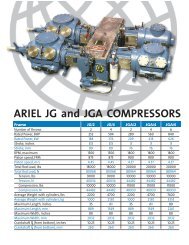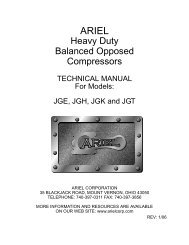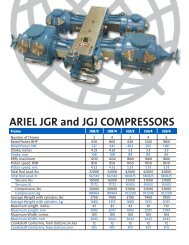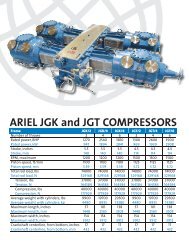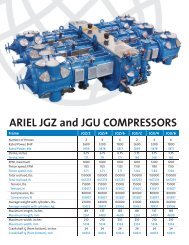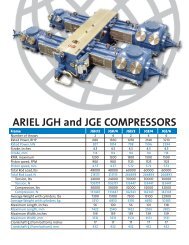Heavy Duty Balanced Opposed Compressors
Heavy Duty Balanced Opposed Compressors
Heavy Duty Balanced Opposed Compressors
You also want an ePaper? Increase the reach of your titles
YUMPU automatically turns print PDFs into web optimized ePapers that Google loves.
FOR MODELS: JG AND JGA<br />
SECTION 6 - TECHNICAL ASSISTANCE<br />
Recommended Maintenance Intervals<br />
Like all equipment, Ariel compressors do require maintenance. The frequency of maintenance<br />
is dictated by the environment in which the compressor is placed, the loads the user<br />
imposes on the compressor and the cleanliness of the gas.<br />
First and foremost on the preventative maintenance list is the completion and compliance<br />
with the Ariel Corporation Packagers Standard and Compressor Start Up Check List. All<br />
items must be adhered to, both before and after start up.<br />
The following is a guide only and, as stated above, may vary due to operating conditions.<br />
The time intervals start from the start up date of the unit. If your oil supplier's recommended<br />
oil service changes are more frequent than the Ariel recommendation, the supplier’s intervals<br />
should be followed. Regular oil analysis is recommended. If problems develop, the oil<br />
should be changed immediately and the cause of the problem determined and corrected.<br />
A log book should be kept with each unit. Every maintenance item can be recorded with<br />
exacting detail in order that records will be available for tracking maintenance cost per unit<br />
and for trouble-shooting.<br />
Operator logs should be reviewed by qualified personnel to determine trends in compressor<br />
performance and/or maintenance.<br />
Daily (see www.arielcorp.com for latest Recommended Maintenance Intervals, ER-8.2)<br />
1. Check frame oil pressure. It should be 50-60 PSIG (350-420 kPa) when at operating<br />
temperature. Compressor inlet oil temperature is 190°F (88°C) maximum.<br />
2. Check frame oil level. Oil should be visible at approximately mid-level in the<br />
sight glass when the compressor is running. If not, determine and correct the<br />
problem. Do not overfill. Check oil makeup tank for sufficient oil supply.<br />
3. Check lubricator block cycle movement indicator. Refer to information plate on<br />
top of lubricator box for correct cycle time. Very dirty or wet gas may require a<br />
more frequent cycle time than normal.<br />
4. Check primary and secondary packing vents for blowing. If blowing, determine<br />
cause and, if necessary, replace packing internal parts.<br />
5. Check and correct any gas leaks.<br />
6. Check and correct any oil leaks.<br />
7. Check operating pressure and temperatures. If not normal, determine cause of<br />
abnormality. It is recommended that a daily log of operating temperatures and<br />
pressure be kept for reference.<br />
8. Check shutdown set points.<br />
11/01 PAGE 6 - 1





